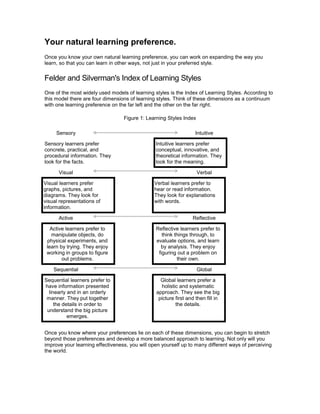Your natural learning preference
- 1. Your natural learning preference.<br />Once you know your own natural learning preference, you can work on expanding the way you learn, so that you can learn in other ways, not just in your preferred style. <br />Felder and Silverman's Index of Learning Styles<br />One of the most widely used models of learning styles is the Index of Learning Styles. According to this model there are four dimensions of learning styles. Think of these dimensions as a continuum with one learning preference on the far left and the other on the far right.<br />Figure 1: Learning Styles Index<br />SensoryIntuitive<br />Sensory learners prefer concrete, practical, and procedural information. They look for the facts. Intuitive learners prefer conceptual, innovative, and theoretical information. They look for the meaning.<br />VisualVerbal<br />Visual learners prefer graphs, pictures, and diagrams. They look for visual representations of information. Verbal learners prefer to hear or read information. They look for explanations with words.<br />ActiveReflective<br />Active learners prefer to manipulate objects, do physical experiments, and learn by trying. They enjoy working in groups to figure out problems. Reflective learners prefer to think things through, to evaluate options, and learn by analysis. They enjoy figuring out a problem on their own.<br />SequentialGlobal<br />Sequential learners prefer to have information presented linearly and in an orderly manner. They put together the details in order to understand the big picture emerges. Global learners prefer a holistic and systematic approach. They see the big picture first and then fill in the details.<br />Once you know where your preferences lie on each of these dimensions, you can begin to stretch beyond those preferences and develop a more balanced approach to learning. Not only will you improve your learning effectiveness, you will open yourself up to many different ways of perceiving the world. <br />
